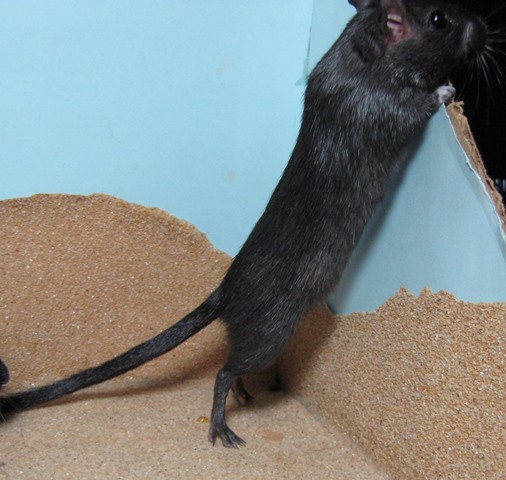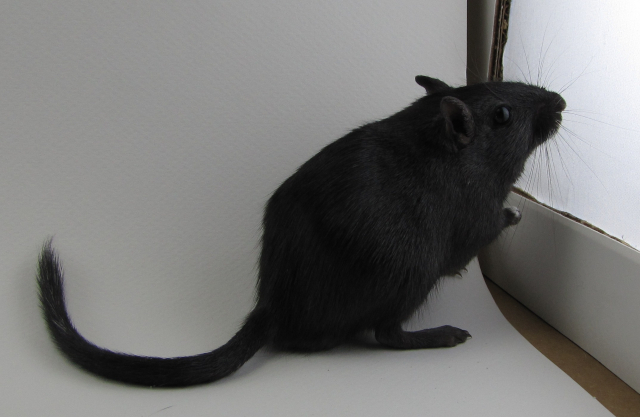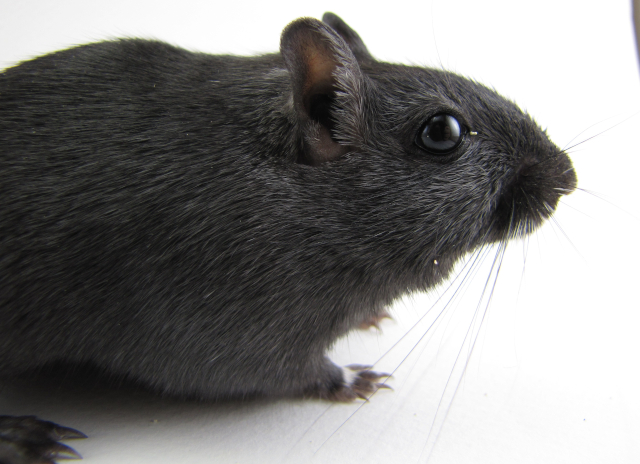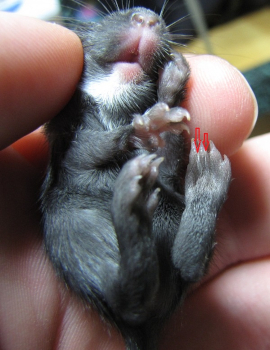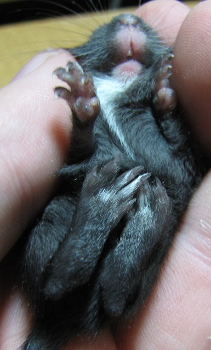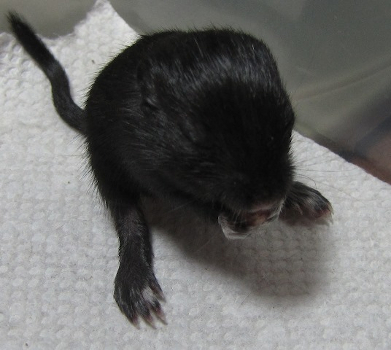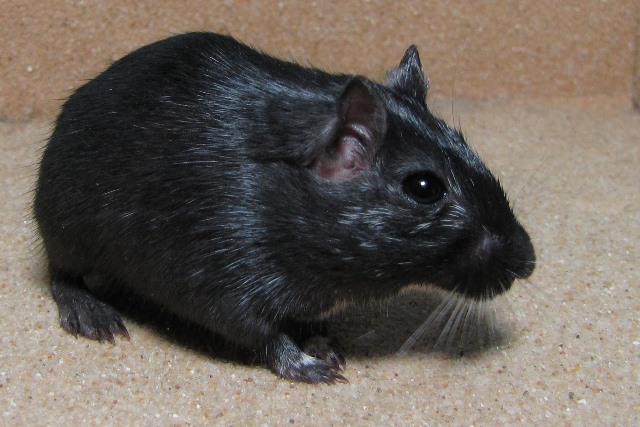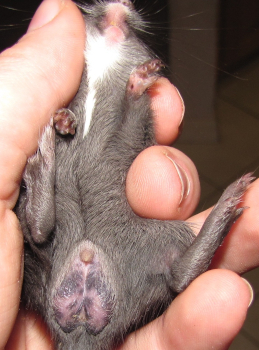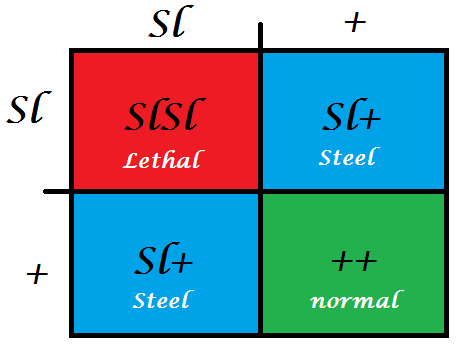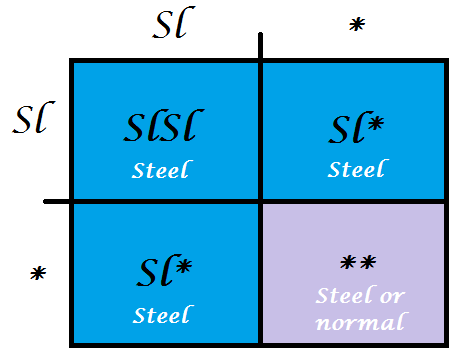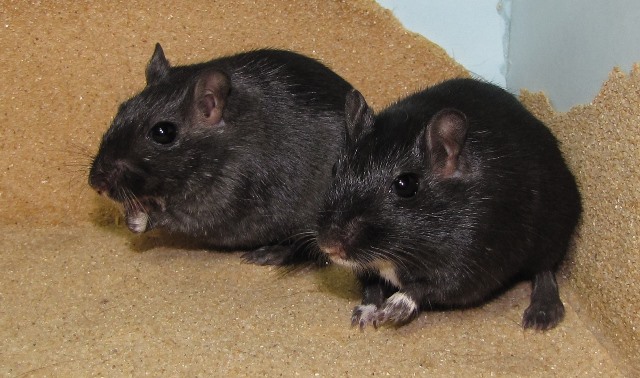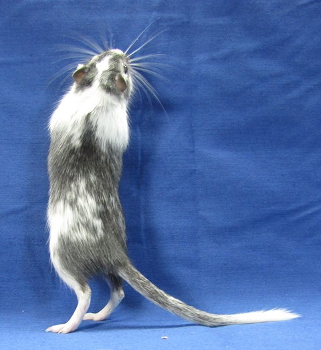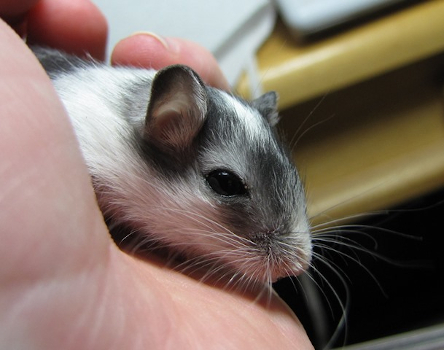A New Mutation in the Mongolian Gerbil: Steel
Oct. 2013
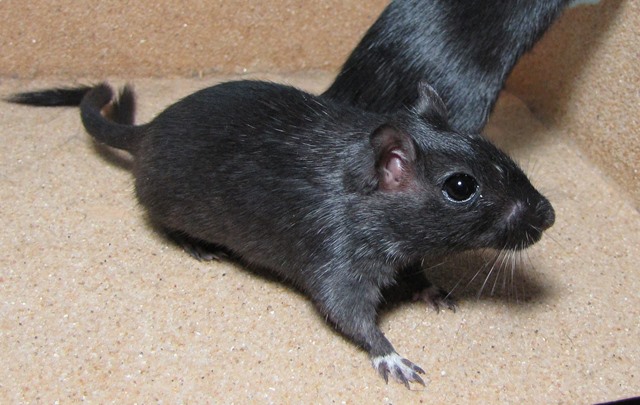
There is evidence of a new color mutation in gerbils, causing slight coat dilution increasing towards the belly, white flecking, and white marks on the rear paws on a self (aa) background.
Adult Steel-Black (aa Sl*) showing fading along the flanks towards the belly and white flecks on the side of the neck
So far, all evidence points to this being homologous to the gene "Steel" in lab mice. As such, the gerbil mutation will be referred to as Steel (symbol Sl) for the purposes of this article. The presence of Steel cannot be visually identified with any reliability on Agouti, Argente, or Lilac backgrounds, so Steel-Black (aa Sl+) will be referred to as simply "Steel". Other colors are written as Steel-Agouti, Steel-Argente, etc. So far, the mutation has only been seen in combination with Agouti, Black, Argente, Lilac, and Dominant Spot. Interaction with other color genes is unknown.
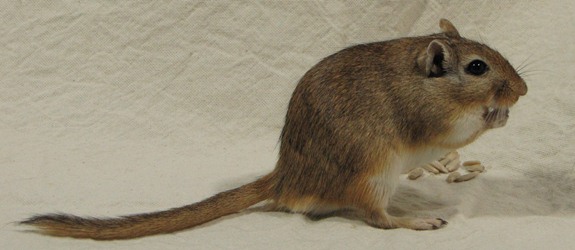
This male won Best in Show at the 2011 AGS Virtual Show. Though he was judged as an Agouti, he was later proven to be a Steel-Agouti!
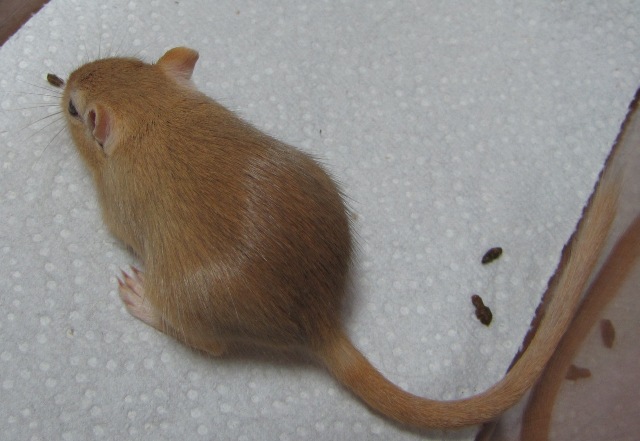
This was a suspected Steel-Argente, but she was never bred to confirm.
Even on Black, the effects of Steel are subtle. Below is an adult male Steel. From this photo, he could easily be mistaken for a Black-- but note the white hairs at the end of his tail.
Below is the same Steel, with the lighting at just the right angle to show that the coat is not a true, deep black, but rather a charcoal color.
This dilution can be seen best on mature adults and young pups.
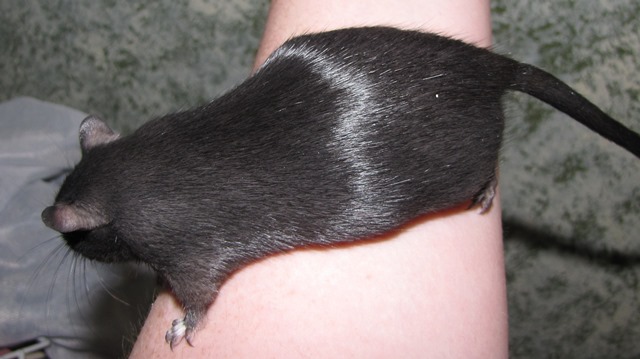
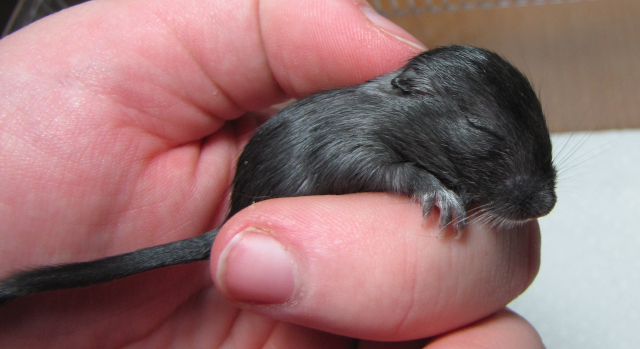
A much more reliable way of identifying Steel gerbils is by looking at the back paws. Steel gerbils have varying amounts of white fur on the underside of the back paws: from a few hairs' worth, to markings that wrap around a toe onto the top side of the paw. These paw markings are most easily seen when the gerbil is 1-4 weeks old, especially when there's very little white to be seen. Part of the difficulty in identifying Steel on colors other than Black is the inability to see these paw markings; they can't be seen on the already-white paws of Agouti or Argente, and there's not enough contrast to make them out on Lilac.
Aside from the dilution and white on the paws, Steels also have white flecks throughout the coat, increasing with age.
Other quirks that have been noticed include patchy brownish molts, clear nails, and partially unpigmented genitals.
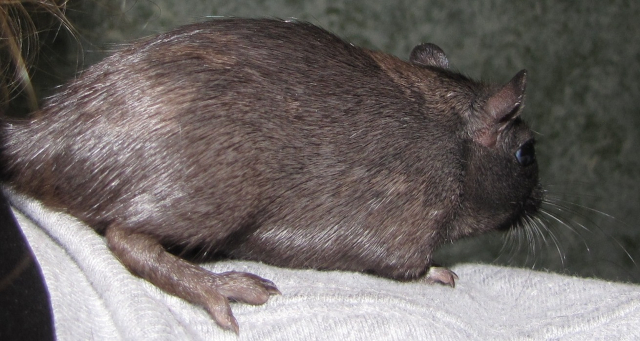
Crossing a Steel with an unrelated non-Steel gives Steel pups, proving that this mutation is not recessive.Mode of Inheritance
One theory is that Steel is semi-dominant and homozygous-lethal, just like Dominant Spot (Sp). Crossing two Steels (Sl* x Sl*) gives Steel (Sl*) pups, but no corresponding "double-Steel" (SlSl) phenotype. Nor is there any significant decrease in Steel/Steel litter sizes. The assumption, then, is that "double-Steel" pups are like double-DS (SpSp) pups: reabsorbed early in development and replaced with viable embryos.
However, to date, no Steel parent has ever produced a pup that can be conclusively identified as non-Steel.
This could be explained by the mutation being completely dominant, or close to it, with the homozygotes (SlSl) being very similar in appearance to the heterozygotes (Sl+). The lack of non-Steel pups coming from Steel parents could then be due to one or both parents being homozygous Steel (SlSl).
This theory could also explain the wide variation in how diluted different Steel gerbils appear. The two gerbils below are both Steel, and very close in age. Yet the female on the left is much more faded. They are a breeding pair, and have produced only Steel pups. Could the lighter female be homozygous Steel (SlSl)?
There do appear to be modifiers influencing the extent of the "extra" white marks on Steels, working independently of the modifiers known to control the amount of white in the normal self bibs and knuckle-dusters.
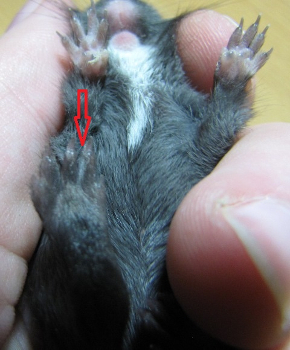
Left, a pup with a fair amount of rear-paw white, but not much bib. Right,
a pup with a fair amount of bib, but barely any rear-paw white.
Steel does appear to interact with Dom Spot on some level. DS Steel (Sp+ Sl*) gerbils have more white flecking, particularly on the tail. With the diluted base coat and extra flecking, they tend towards a very nice Mottled look. They can also show strange patterns, such as having only one side of the body mottled, or having a blaze that dips down to cover an eye.Interaction with Dominant Spot
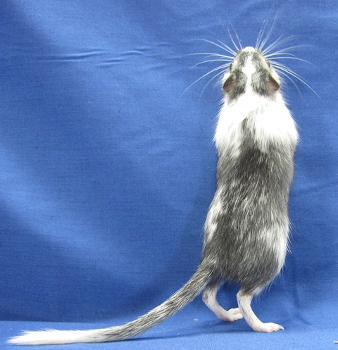
But the strangest part happens when a DS Steel is crossed with another DS gerbil (Sp+ Sl* x Sp+). Pale, sickly runts appear in these litters, surviving less than a week (current record is 5 days). These pups have dark eyes, but never develop pigment on the body. It seems that these runts are the result of Steel interfering with the usual development (or lack thereof) of double-DS (SpSp) pups, significantly extending their viability. Of course, none of these runts can be test bred for confirmation, but they are almost certainly SpSp Sl*.
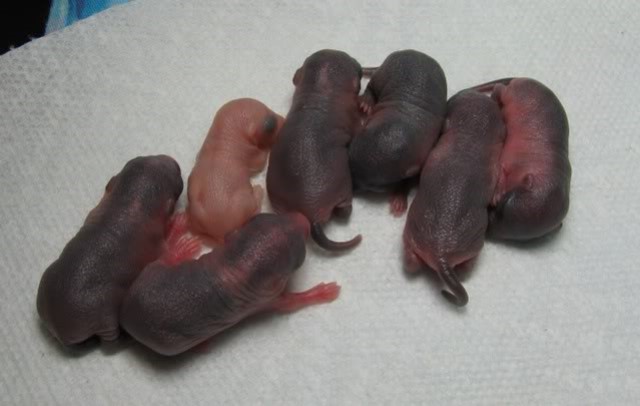
A litter at 4 days old containing an SpSp Sl* pup.
A litter between two DS Steel gerbils is planned, but has not occurred yet.
Steel mutations in the laboratory mouse produce various phenotypes, but all follow a similar pattern.Steel in Mice
"The multiple steel mutations (KitSl) behave in a semidominant fashion and cause deficiencies in pigment cells, germ cells, and blood cells paralleling those caused by the Kit locus mutations (dominant spotting alleles). Many steel alleles cause severe anemia resulting in death in utero of homozygous mutant mice. However, mice homozygous for some steel mutations and compound heterozygotes for two steel alleles (e.g., KitlSlKitlSl-d) are viable and have black eyes and a white coat; they have severe macrocytic anemia, and both sexes are usually sterile due to failure of germ cells to migrate correctly during development. Mice heterozygous for a single steel mutation have diluted coat color with a small amount of white spotting, are viable and fertile, and may have a slight macrocytic anemia."2
A Steel-mutant mouse compared to a normal Black mouse: Profile, Underbelly
One exception of particular interest in relation to gerbils is the "recessive" Steel Dusty (sldu). Steel Dusty homozygotes (sldusldu) "have a slightly diluted coat and small white patches which vary in number from none to extensive white speckling. They are not noticeably anemic."1 Although Steel Dusty is described as recessive, "occasionally sldu+ heterozygotes can be recognized by the fact that they possess whitish toes and the ventral side of their lower jaw is lighter than normal."1 There is no mention of homozygotes being sterile. Unfortunately, this particular mutation is now extinct, and there do not appear to be any publically-available photographs or diagrams depicting Steel Dusty mice.
1. The Coat Colors of Mice, by Willys K. Silvers (Web Version)References
2. JAX Mice Database - 100401 (WCB6F1/J-Kitl/J)F1-Kitl /Kitl /J
3. Mouse Genome Informatics, particularly:
- Kitl MGI Mouse Gene Detail - MGI:96974 - kit ligand
- Kitl<sl-du> Spontaneous Allele Detail MGI Mouse (MGI:1856169)
- Phenotype Images associated with this Gene
Updated information on Steel 2015
Updated information on Steel 2020

Unless otherwise specified, all text and images at this site are licensed under a
Creative Commons Attribution-Noncommercial-Share Alike 3.0 United States License
